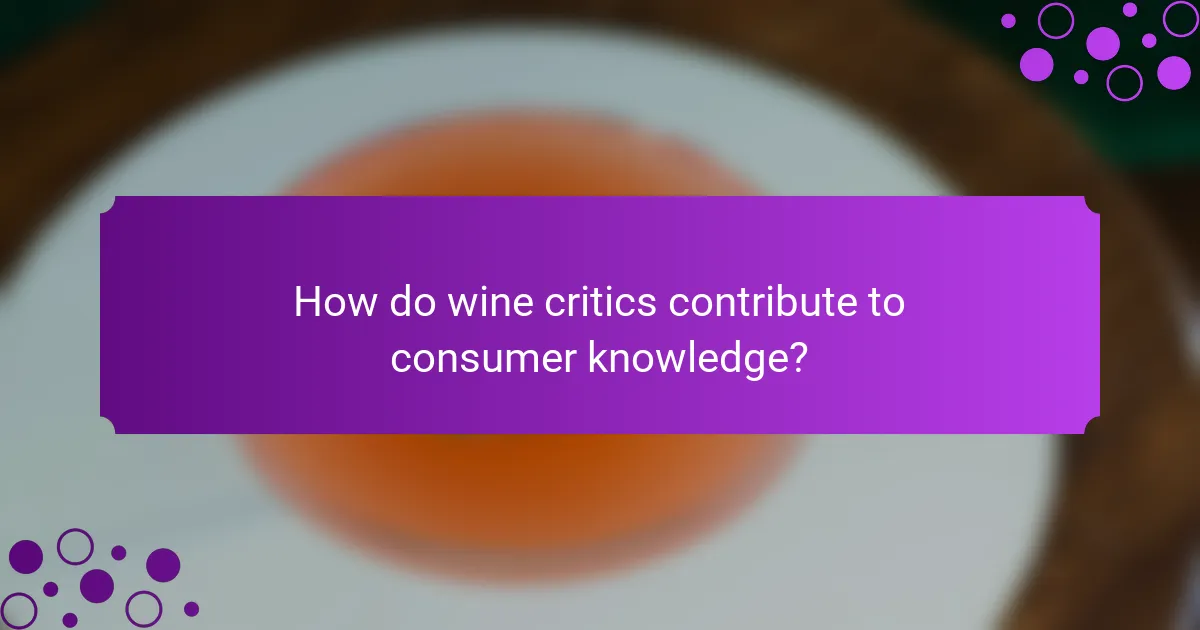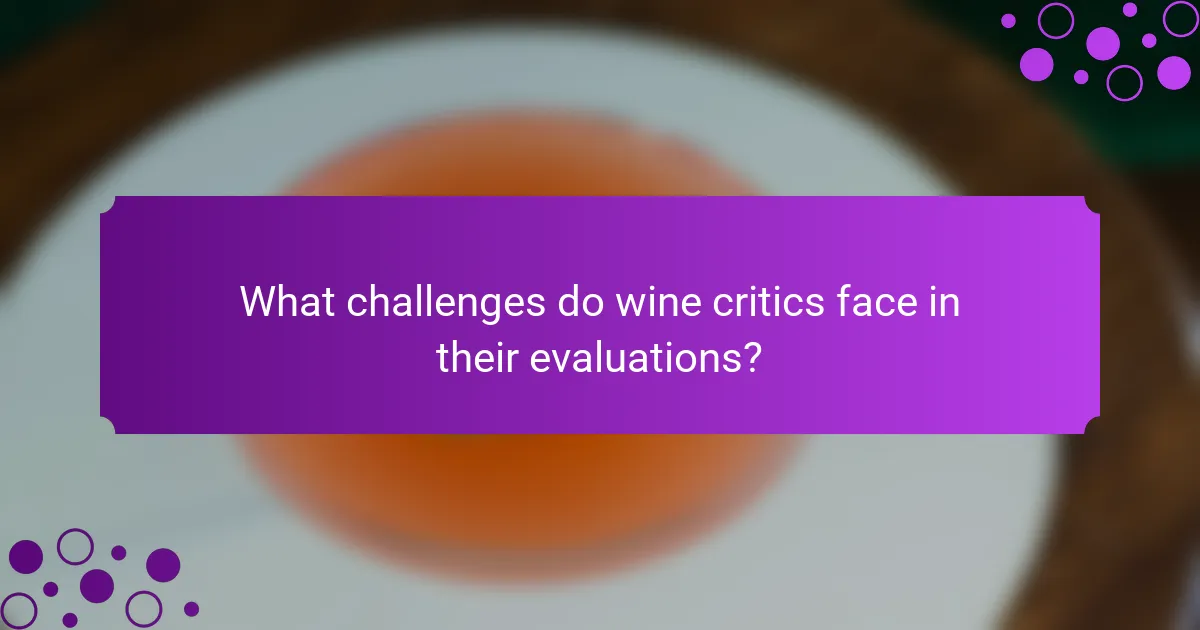
What is the role of wine critics in the wine industry?
Wine critics evaluate and assess wines, influencing consumer perceptions and market trends. They provide detailed reviews that guide buyers in their purchasing decisions. Critics often score wines based on various attributes such as aroma, flavor, and finish. Their ratings can significantly impact a wine’s market value, especially for limited edition releases. For example, a high score from a reputable critic can lead to increased demand and higher prices. Critics also educate consumers about wine styles and regions, fostering greater appreciation. Their expertise helps shape industry standards and trends, making them vital to the wine market.
How do wine critics assess limited edition wines?
Wine critics assess limited edition wines through a combination of sensory evaluation and contextual analysis. They evaluate the wine’s aroma, flavor, and texture. Critics often compare these attributes to established standards and benchmarks. They also consider the wine’s production methods and the reputation of the winery. Limited editions may receive additional scrutiny due to their scarcity and price. Critics may reference historical performance of similar wines in their assessments. Their reviews can significantly influence market perceptions and pricing. This process helps consumers understand the wine’s quality and value.
What criteria do wine critics use to evaluate these wines?
Wine critics use several criteria to evaluate wines. These criteria include appearance, aroma, taste, and finish. Appearance assesses the wine’s color and clarity. Aroma evaluates the complexity and intensity of scents. Taste measures flavor balance, acidity, sweetness, and tannins. Finish looks at the length and quality of aftertaste. Critics also consider the wine’s age and potential for aging. Each criterion contributes to the overall assessment and score given to the wine. These evaluations influence consumer perception and market value.
How do tasting notes influence the perception of limited edition wines?
Tasting notes significantly influence the perception of limited edition wines. These notes provide detailed descriptions of the wine’s aroma, flavor, and mouthfeel. They help consumers understand what to expect from a particular wine. Tasting notes can create an emotional connection, enhancing the perceived value of the wine. Additionally, well-crafted notes often highlight unique attributes that differentiate a limited edition wine from standard offerings. This differentiation can drive demand and justify higher prices. Wine critics’ evaluations, conveyed through tasting notes, can also shape public opinion and market trends. As a result, positive tasting notes can elevate a wine’s reputation and desirability in the marketplace.
Why are wine critics important for market value?
Wine critics are important for market value because their reviews influence consumer perception and purchasing decisions. Their ratings can significantly impact the demand for specific wines. High scores from reputable critics often lead to increased prices and market interest. For example, a wine rated 95 points or higher by a well-known critic can see a price increase of up to 30%. Critics also provide credibility and expert opinions that help guide both collectors and casual buyers. This expert validation can enhance a wine’s reputation and perceived quality. In summary, wine critics shape the market landscape by driving demand and influencing prices through their evaluations.
How does a critic’s rating impact the pricing of limited edition wines?
A critic’s rating significantly influences the pricing of limited edition wines. Higher ratings often lead to increased demand among consumers and collectors. This heightened demand can drive up market prices. Conversely, lower ratings may result in decreased interest and lower prices. For example, wines rated 90 points or higher by renowned critics can see price increases of 20% or more. Historical data shows that wines with high ratings frequently sell at auction for substantially more than their initial retail price. The reputation of the critic also plays a crucial role in this dynamic. Well-respected critics can create a substantial impact on the perceived value of a wine.
What role does reputation play in the influence of wine critics?
Reputation significantly enhances the influence of wine critics. Critics with established reputations are often trusted more by consumers and producers. Their assessments can sway public perception and market demand. For instance, a highly regarded critic’s positive review can lead to increased sales for a limited edition wine. Conversely, a negative review from a reputable critic can diminish a wine’s market value. Studies show that critics’ ratings can affect auction prices and retail sales. Therefore, reputation serves as a key factor in determining the impact of wine critics on the market.

How do wine critics contribute to consumer knowledge?
Wine critics enhance consumer knowledge by providing expert evaluations of wines. They assess various attributes such as aroma, flavor, and quality. Their reviews often include detailed tasting notes and ratings. This information helps consumers make informed purchasing decisions. Critics also contextualize wines within broader market trends. They often highlight the unique aspects of limited edition wines. By doing so, they create awareness about specific offerings. Their influence can significantly affect consumer perceptions and preferences.
What information do wine critics provide to consumers?
Wine critics provide consumers with evaluations of wine quality and characteristics. They assess attributes such as aroma, flavor, and texture. Critics often assign numerical ratings to wines, helping consumers gauge quality. They also provide tasting notes that describe specific flavors and aromas. Wine critics may discuss the wine’s origin and vintage, offering context for its characteristics. Their reviews can influence consumer purchasing decisions significantly. Critics often highlight food pairings that complement specific wines. They may also analyze market trends and pricing, guiding consumers on value. These insights help consumers make informed choices in the wine market.
How do wine reviews help consumers make purchasing decisions?
Wine reviews assist consumers in making purchasing decisions by providing expert evaluations of wine quality. These reviews often include detailed tasting notes, which describe flavors, aromas, and overall impressions. Consumers rely on this information to identify wines that match their preferences. Reviews can also highlight the reputation of the winery or vintage, influencing perceived value. According to a study published in the Journal of Wine Economics, positive reviews can significantly boost sales. This shows that consumers often trust critics’ assessments over personal exploration. Additionally, wine ratings serve as a quick reference for quality assessment. Overall, wine reviews guide consumers toward informed choices in a complex market.
What are the common misconceptions about wine critics?
Common misconceptions about wine critics include the belief that they are elitist and only cater to wealthy consumers. Many assume that critics only provide subjective opinions without any expertise. Another misconception is that wine ratings are solely based on personal taste rather than established criteria. Critics often use specific tasting notes and industry standards to evaluate wines. Some people think that wine critics are biased toward certain brands or regions. However, many critics strive for objectivity and transparency in their reviews. Additionally, it is believed that critics have a significant influence on consumer choices, but their impact can vary widely. Research shows that while critics can shape trends, many consumers also rely on personal preferences and recommendations from peers.
How do critics’ opinions shape trends in the wine market?
Critics’ opinions significantly influence trends in the wine market. Their reviews and ratings create perceptions of quality and desirability. High scores from reputable critics can boost a wine’s visibility and sales. This effect is often seen with limited edition wines, where scarcity amplifies demand. For example, wines rated 95 points or higher often experience price increases. Critics shape consumer preferences through their recommendations. They can also impact producers’ marketing strategies. Ultimately, critics serve as gatekeepers in the wine industry, affecting market dynamics. Their influence is evident in auction prices and retail trends.
What trends have been influenced by wine critics in recent years?
Wine critics have significantly influenced trends in the wine industry in recent years. One major trend is the increased focus on quality over quantity. Critics’ ratings have driven consumers to prioritize highly rated wines. This has led to a surge in demand for limited edition and boutique wines. Additionally, wine critics have popularized the concept of terroir, emphasizing the importance of regional characteristics. The rise of social media has also allowed critics to reach wider audiences, impacting purchasing decisions. Critics’ reviews often shape market prices, as wines with high ratings fetch premium prices. Consequently, producers are now more attentive to critics’ feedback in their winemaking processes. These trends reflect the growing power of wine critics in shaping consumer preferences and market dynamics.
How do critics’ endorsements affect the popularity of certain wines?
Critics’ endorsements significantly enhance the popularity of certain wines. Positive reviews from reputable wine critics create a perception of quality. This perception influences consumer purchasing decisions. Wines that receive high scores or favorable comments often see increased sales. For example, a wine rated 90 points or higher by a well-known critic can sell out quickly. Additionally, critics’ endorsements can lead to higher prices in the market. This phenomenon is evident in auction results where critically acclaimed wines fetch premium prices. Overall, critics play a crucial role in shaping consumer interest and market dynamics in the wine industry.

What challenges do wine critics face in their evaluations?
Wine critics face several challenges in their evaluations. Subjectivity is a primary challenge, as personal taste influences opinions. The vast diversity of wine styles complicates consistent assessments. Critics often encounter pressure from producers, which can bias evaluations. Additionally, the evolving market trends can affect the relevance of their judgments. Limited information about certain wines can hinder thorough evaluations. Critics also deal with the challenge of communicating complex flavors effectively. Lastly, time constraints can impact the depth of their analysis. Each of these challenges can affect the overall reliability of wine evaluations.
What biases might wine critics encounter?
Wine critics might encounter several biases that affect their evaluations. One common bias is confirmation bias. Critics may favor wines that align with their preconceived notions or preferences. Another bias is the halo effect, where a critic’s overall impression of a winery influences their judgment of a specific wine. Additionally, critics may experience peer pressure, leading them to conform to popular opinions within their community. The influence of brand reputation can also skew judgments, as established brands may receive more favorable reviews regardless of the wine’s actual quality. These biases can impact the perceived market value of limited edition wines, as critics’ assessments shape consumer perceptions and purchasing decisions.
How do personal preferences impact a critic’s review?
Personal preferences significantly influence a critic’s review. Critics often bring their own tastes and experiences to their evaluations. This subjectivity can shape their perception of a wine’s quality. For example, a critic who favors bold flavors may rate a delicate wine lower. Additionally, personal biases towards certain regions or grape varieties can affect their opinions. Critics may also have emotional connections to specific wines, altering their objectivity. Research shows that a critic’s background and preferences can lead to varied ratings for the same wine. This variability highlights the importance of understanding a critic’s perspective when interpreting reviews.
What external factors can influence a critic’s judgment?
External factors that can influence a critic’s judgment include personal biases, social influences, and market trends. Personal biases arise from a critic’s previous experiences and preferences. These biases can shape their perception of a wine’s quality. Social influences involve the opinions of peers and industry professionals. Critics may adjust their judgments based on prevailing trends in the wine community. Market trends also play a significant role. The popularity of certain wine regions or varietals can affect how a critic evaluates a wine. Additionally, exposure to marketing campaigns can sway opinions. Critics may be influenced by the reputation of a winery or brand. All these factors combine to create a complex environment for wine evaluation.
How can wine critics maintain credibility in their reviews?
Wine critics can maintain credibility in their reviews by adhering to a strict code of ethics and transparency. They should disclose any potential conflicts of interest, such as receiving samples from wineries. Consistency in their tasting methodology enhances reliability. Critics must also provide detailed tasting notes that explain their evaluations clearly. Engaging in continuous education about wine trends and regions helps critics stay informed. Peer reviews and collaboration with other experts can validate their assessments. Lastly, maintaining an independent voice, free from commercial influences, solidifies their reputation.
What best practices should wine critics follow to ensure impartiality?
Wine critics should follow several best practices to ensure impartiality. First, they must maintain a consistent evaluation method. This includes using standardized tasting notes and scoring systems. Second, critics should avoid conflicts of interest. They should not accept gifts or favors from wineries. Third, critics should be transparent about their affiliations. Disclosing any relationships with wine producers is essential. Fourth, blind tastings can help eliminate bias. Critics should taste wines without knowing their labels. Fifth, they should diversify their wine selections. This prevents favoritism towards specific brands or regions. Finally, critics should continuously educate themselves. Staying informed about wine trends and production methods enhances objectivity. These practices help uphold the credibility of wine criticism.
How can critics effectively communicate their evaluations to the public?
Critics can effectively communicate their evaluations to the public by using clear, concise language. They should provide detailed descriptions of the wine’s attributes, such as aroma, flavor, and finish. Utilizing a standardized scoring system can help convey their assessments quantitatively. Critics should also engage with audiences through various platforms, including social media and blogs. Sharing personal anecdotes can make evaluations more relatable. Additionally, critics can participate in tastings and events to discuss their evaluations directly with consumers. Providing contextual information, such as the wine’s origin and production methods, enhances understanding. Transparency about biases and preferences builds trust with the audience. These methods collectively foster a better connection between critics and the public.
What are some tips for consumers when interpreting wine critiques?
Consumers should consider the critic’s background and expertise when interpreting wine critiques. Understanding the critic’s experience can provide context to their evaluations. Look for consistent terminology used in wine descriptions. Familiarity with terms can enhance comprehension of the critique. Pay attention to the tasting notes provided. These notes often highlight specific flavors and aromas. Note the scoring system used by the critic. Different critics may have varying scales, impacting the interpretation of scores. Compare critiques from multiple sources for a well-rounded view. This helps mitigate bias from a single critic’s perspective. Finally, consider personal taste preferences alongside critiques. Personal enjoyment can differ from professional evaluations, influencing purchasing decisions.
How can consumers differentiate between subjective and objective reviews?
Consumers can differentiate between subjective and objective reviews by analyzing the language and content of the reviews. Objective reviews present factual information, such as tasting notes, chemical composition, or historical context. These reviews often include specific details that can be measured or verified. In contrast, subjective reviews are based on personal feelings, preferences, or opinions. They typically use emotional language and may describe personal experiences rather than factual attributes.
For example, an objective review might state, “This wine has 13% alcohol content and notes of cherry and oak.” A subjective review might say, “I loved the rich flavor of this wine; it made me feel happy.” Recognizing these differences helps consumers make informed decisions about the wines they choose.
What strategies can consumers use to enhance their wine purchasing experience based on critiques?
Consumers can enhance their wine purchasing experience by leveraging critiques effectively. First, they should read professional wine reviews to understand quality indicators. Reviews often highlight flavor profiles, aging potential, and food pairings. Second, consumers can compare ratings from multiple sources to gain a broader perspective. This helps in identifying consistent quality across critiques. Third, utilizing wine apps that aggregate reviews can streamline the decision-making process. These apps often provide user-generated feedback alongside expert opinions. Fourth, attending wine tastings can offer firsthand experience of wines before purchase. This practical exposure can validate or contradict written critiques. Lastly, consumers should consider the critic’s background and expertise. Critics with a solid reputation often provide more reliable evaluations. By applying these strategies, consumers can make informed choices and enhance their overall wine purchasing experience.
The main entity of the article is wine critics, who play a crucial role in determining the market value of limited edition wines. The article outlines how wine critics evaluate wines through sensory assessments and established criteria, influencing consumer perceptions and market trends. It discusses the impact of critics’ ratings on pricing, the importance of tasting notes, and the challenges critics face in maintaining objectivity and credibility. Additionally, it addresses common misconceptions about wine criticism and offers strategies for consumers to enhance their purchasing decisions based on critiques.